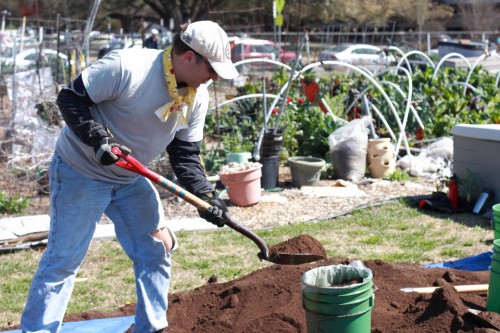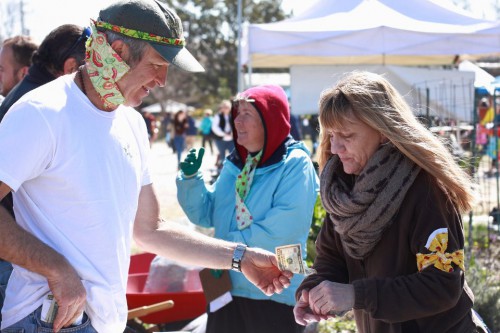The Garden That Gives Together
In the heart of Austin, Texas, a sprawling three-acre community garden teems with life: young couples and retirees work alongside each other, planting their first plot or harvesting their 30th season of heirloom tomatoes. Since its founding in 1974, Sunshine Community Gardens has made a name for itself as one of the largest community gardens in the nation.
Started by the University YWCA, the garden moved to an intramural field before claiming its current location in 1983 on the property of the Texas School for the Blind and Visually Impaired. In its early days Sunshine was partly funded by the City of Austin and Travis County, but in 2005, Sunshine assumed autonomy as a member-owned and run cooperative.
Sunshine runs on sweat, membership dues, and an annual plant sale. Aside from a free loan from the State of Texas to use three acres on the property of the School for the Blind, Sunshine doesn’t receive any outside assistance. Members pay annual dues to rent 220 plots ranging in size from 10’x10’ to 20’x’20’. But the bulk of the funding for the garden comes through an annual plant sale—Austin’s largest plant sale. At $2 a plant, they sell over 300 varieties of organically grown tomatoes and peppers, as well as a range of native and specimen plants.
“There were 1,800 people in line before we opened,” says Jack McEvoy, former Sunshine president.
Members also contribute at least one hour of volunteer service—mowing, weeding, tool repair—each month. Many members contribute their professional skills as lawyers, CPAs, AC repairmen, plummers, etc. toward more complex needs.
New York native Ila Falvey, who was just elected to be Sunshine’s new president, has been cultivating a plot at the garden for the past 20 years, and loves it.
“You get food, you get exercise, you get vitamin D . . . it’s a sense of freedom.”
Birth of the community gardening movement
This sense of freedom—to grow one’s own food, to be healthy, to enjoy the company of others while working in the soil—is no new phenomenon. After both World Wars, there was an explosion of community gardens—also called “Victory Gardens”—across the country, as citizens tried to boost the war effort by reducing pressure on food supply. In 1944, victory gardens produced 42 percent of the nation’s food supply. In 1976, the USDA launched the Urban Gardening Program that channeled government dollars toward the building and sustaining of community vegetable gardens in 23 cities across the country. But when Congress defunded the program in 1993, many of the gardens struggled to survive; many ceased. Those that weren’t dependent on government dollars, survived and flourished.
Today, there are about 3,000 community gardens registered with the American Community Gardening Association (ACGA), and an estimated (though not substantiated) 20,000 across North America.
The ACGA defines a “community garden” broadly: “It can grow flowers, vegetables or community. It can be one community plot, or can be many individual plots. It can be at a school, hospital, or in a neighborhood. It can also be a series of plots dedicated to ‘urban agriculture’ where the produce is grown for a market.’ ”
These days, there are lots of reasons for community gardening. On a merely aesthetic level, they can be places that foster art and ecological understanding, as in New York City’s Clinton Community Garden or Peralta Community Garden in Berkeley, Ca. Many researchers have pointed to the probable health benefits that accompany gardening. According to a 2000 study by Donna Armstrong in Health & Place Journal, community gardeners tend to consume more fresh vegetables and less sweet foods and drinks compared with non-gardeners. Others refer to the stress-reducing aspects of gardening.
Some have pointed to the economic benefits. Armstrong claims that those who work in a community garden save between $50 and $250 per season in their food budget. And people who live near thriving community gardens might see a jump in their property values. In a New York University School of Law study of 636 NYC community gardens, sales prices of residential properties within a 1,000-foot radius of a garden were higher than those outside the radius. The researchers estimated that community gardens would create $1 million in tax revenue per garden for the city over 20 years.
Similarly, the social benefits of community gardening, while not fully quantified, are palpable. At least one study has concluded that community gardens contribute to crime reduction in the surrounding neighborhoods, at least in terms of reductions in certain gun crimes and improvements in residents’ perceptions of safety. Mark Francis, a professor at the University of California at Davis, speaks of the community-building nature of such gardens: “The spaces provide opportunities for neighborhood residents to develop and control part of their neighborhood, an advantage not afforded by traditional parks. Gardens are active places that people make themselves, use for work and socializing, and ‘love.’ ”
A place for the hungry
That’s perhaps what many Sunshine members love most about their garden: the opportunity to contribute to the larger community.
Since 2003, members have donated pounds of fresh produce to a local food bank, Micah 6. In fact, a sixth of an acre at Sunshine has been designated specifically for this purpose, and members can opt to give above and beyond from their own gardens as well.
“We don’t take second hand stuff,” says Nancy Siebert who helps coordinate the Micah 6 garden and has been a member of Sunshine for 15 years. She tells other gardeners, “I don’t want anything you wouldn’t take home and put on your own table.”
Twice a week during the summer, Sunshine members harvest, clean, and deliver somewhere between 25 and 40 pounds of produce to Micah 6. This produce will go directly to the pantry store where low-income Austin residents can stock up on fresh food.
“It’s all very nice, it’s beautiful,” says Joe Bell, Pantry Director. “There are lots of eggplants, plenty of different kinds of greens—plenty of stuff we don’t get from our normal source.”
In fact, Bell explains that if it weren’t for Sunshine, Micah 6 probably wouldn’t have fresh produce to offer its clients. And for many of the folks who come through Micah 6, having access to fresh fruits and vegetables is both a luxury and a necessity.
“Produce is the very best thing to have at a pantry,” Bell explains. “Many of our clients are people who have only limited access to cooking facilities . . . But with produce, you can just eat it.”
Last year, Sunshine donated 2,432 pounds of produce to Micah 6.
Intentionally, the group of gardeners tries to make sure they have excess that they can pass along to others in need—whether it’s in the form of fresh produce—or in the form of financial contributions to others. Recently, they supported a local community that was impacted by a fire.
“We’re self-sustaining and we have money left over for good work,” Siebert says. “We don’t get gifts. We give gifts.”
And sometimes that giving happens unintentionally. Although rare, “We do have some theft,” Falvey says. But they tend not to lose sleep over it: “We believe that if someone is stealing produce they are hungry and need to eat . . . It is annoying when someone takes your only head of cauliflower, but we complain, and survive.”
[Z1]Need for this to be confirmed








